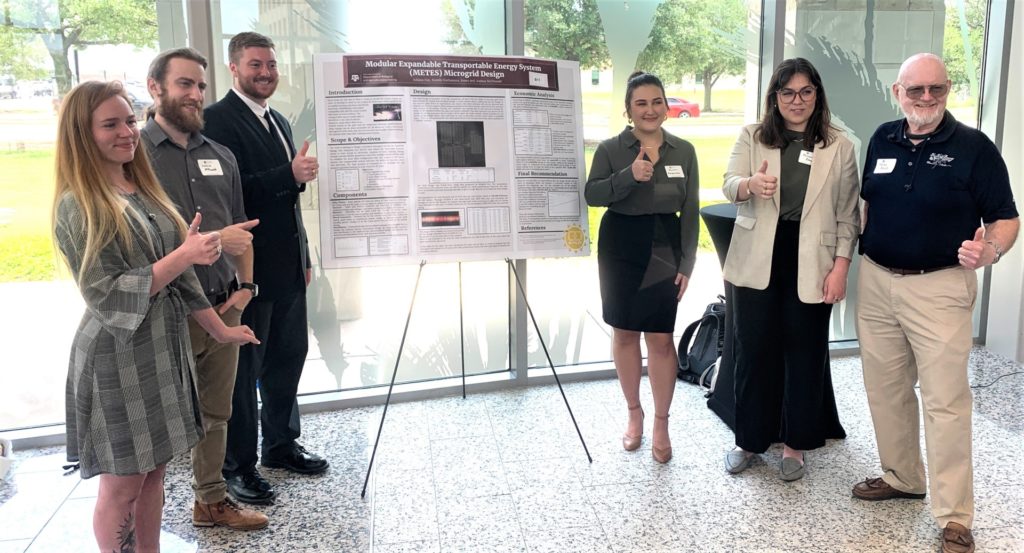Capstone projects turn students into professionals
Engineering students transition to real-world in culmination course
Providing engineering input to create a transportable solar power system started as a capstone project for Kerena Reese ‘21, but it turned into an entrepreneurial venture in the niche renewable energy market.

In 2020, Reese, an engineering major in the Department of Biological and Agricultural Engineering, BAEN, participated in a capstone project for TeraVolt Energy to design battery storage for a Modular Expandable Transportable Energy System, METES.
For TeraVolt Energy president and CEO James “Hoss” Boyd, senior students’ capstone projects have provided his company with invaluable expertise, and he has provided multiple projects for students over the past five years.
Boyd said students like Reese provide fresh ideas, youthful energy and enthusiasm to the projects. But both Reese and Boyd agree the capstone course is a two-way street.
“The students learn about a segment of industry they may not have considered and introduces them to how much there is to know in industry settings, from dealing with the customer to vendors and contractors,” Boyd said. “It is an incredible value for the students as they look toward entering their career. It also provides me with expertise and talent my company could not access otherwise.”
Culmination of education with capstone project
The capstone project is the educational culmination course for senior students in the department and its Agricultural Systems Management, AGSM, track.
Greg Stark, BAEN associate professor of practice, said the capstone course represents students’ first attempt to apply what they learned throughout their undergraduate education and work with clients to solve real-world, agriculturally related issues.
Clients range across the spectrum of agriculture from the Texas Cotton Ginners Association, which provides three projects annually, to international companies from Lebanon to Ecuador.
The scope of capstone projects ranges across the agricultural and natural resource spectrum from water or air filtration systems, wastewater treatment and greenhouse gas emission mitigation to building a commercial pine nut dryer.
AGSM and BAEN students pick projects and are assigned teams, Stark said. There is no contract, and no money is exchanged. Students provide progress reports to faculty every two weeks to make sure the projects are on schedule.
At the end of the course, students make two final presentations, including a PowerPoint and poster session with all the teams, faculty and clients in attendance.
Stark said the experience students gain goes beyond application of in-class learning, including gaining an understanding of the demands engineering projects present beyond designing, building and implementation.
“They learn very quickly that projects are as much about people and communication as they are about engineering,” he said. “You’re working on a team and answering to project managers and faculty and the client. There are expectations and objectives, and the experiential learning they gain moves them from student to professional.”
Jumpstarting careers with capstone projects
Russell McGee, assistant instructional professor and director of the AGSM undergraduate program, said the perspective capstone project’s provide students is invaluable in relation to their entry into their respective professions.

As with Reese, the projects provide students with experience that parallels real-world problem-solving in an academic setting. This is important because it introduces students to the rigors and challenges engineering projects can present but maintains the room for mistakes and learning from them, McGee said.
“We joke that the students get paid in grades, but it is really more than that,” he said. “The experience and the project tend to parallel the paths they go on in their careers. There are internships and job opportunities waiting for many students, and what it does for their resume can jumpstart their career.”
McGee and Stark said the projects show AGSM and BAEN students how their roles parallel and complement each other throughout the project. Engineering students focus on design and build whereas agriculture system manager students consider the economic feasibility and long-term value a system can provide the client.
Most clients are former students of the department, McGee said. They often provide projects for the program and actively educate students about applying their engineering knowledge in the field.
Students must consider both sides of the equation and the client’s budget as well as the project’s location and environment and the infrastructure that will support the design.
“It reinforces what they’ve learned but also introduces them to collaborations across the design-build spectrum and real-world considerations like economic implementation for a business,” he said. “Working within physical, financial and environmental parameters is a very important lesson for these students to learn.”
Carving out a place in renewable energy
Reese said the capstone course opened her eyes to the challenges and opportunities her profession can present. While she said it was a team effort, she noted the efforts provided various perspectives and outcomes for her and other individual members.
Graduates will take different professional routes, but the capstone course puts most on a good trajectory, she said.
Boyd said the course gives individual BAEN and AGSM graduates a solid professional foundation, access to peer, professional and industry networking, and job opportunities. He plans to continue providing capstone projects to the department and its students as he continues to improve his products’ capabilities.
Reese continues to work on designs that will help TeraVolt compete in the renewable energy market, and help Boyd carve out the company’s place in it.
“It’s real-world,” she said. “There is a big difference in working on a project for a year and manifesting it in real life rather than learning hypotheses, equations and procedures. When you’re creating something, you can’t wait to physically touch it and see it come to fruition.”


